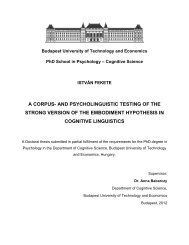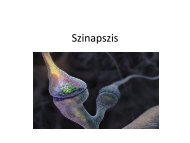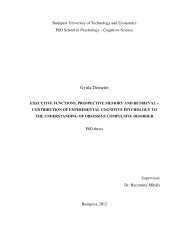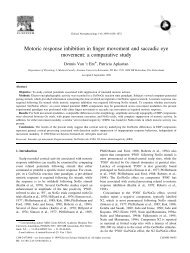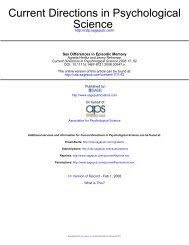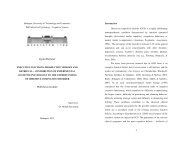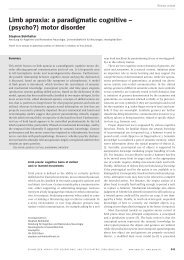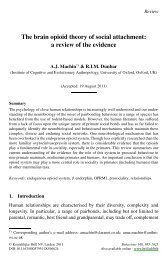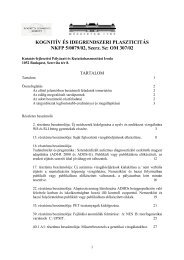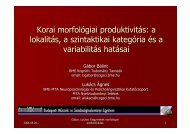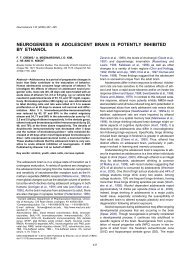Verbs: some properties and their consequences for agrammatic ...
Verbs: some properties and their consequences for agrammatic ...
Verbs: some properties and their consequences for agrammatic ...
Create successful ePaper yourself
Turn your PDF publications into a flip-book with our unique Google optimized e-Paper software.
242<br />
R. Bastiaanse et al. / Journal of Neurolinguistics 15 �2002) 239±264<br />
verb remains in its base-generated position. This is illustrated in �1±3), where t designates<br />
the canonical verb position, which is co-indexed with the Verb Second position.<br />
�1) Matrix sentence without modal verb/auxiliary<br />
�2) Matrix sentence with modal verb<br />
�the boy wants to buy a bike)<br />
�3) Embedded clause without modal verb/auxiliary<br />
�ik denk) dat de jongen een ®ets koopt<br />
�I think) that the boy a bike buys<br />
�I think that the boy buys a bike)<br />
Here it is assumed that a verb is inserted in the structure in fully in¯ected <strong>for</strong>m<br />
�Chomsky, 1995; <strong>for</strong> Dutch syntax, see Zwart, 1993). In the embedded clause, the ®nite<br />
verb remains in its base-generated position; in matrix clauses, only the ®nite verb moves to<br />
the left, the non-®nite verb stays behind.<br />
In English, an SVO-language, overt verb movement is restricted to auxiliaries <strong>and</strong> only<br />
found in questions �see 4).<br />
�4)<br />
The word order in declarative matrix <strong>and</strong> embedded clause is the same, however,<br />
contrary to Dutch. So, one of the <strong>properties</strong> of verbs is that <strong>their</strong> position in the sentence<br />
varies due to obligatory movement rules. It is this property that is subject of our ®rst study.<br />
Dutch <strong>agrammatic</strong> patients have serious problems with the production of ®nite verbs in<br />
<strong>their</strong> spontaneous speech. Bastiaanse <strong>and</strong> Jonkers �1998) showed that the proportion of<br />
®nite verbs these patients produce is signi®cantly lower than in normal speech. Bastiaanse<br />
et al. �2000) suggested that this might be due to problems with verb movement: <strong>agrammatic</strong><br />
aphasics are signi®cantly more impaired in the production of ®nite verbs in the<br />
matrix clause than in the embedded clause �in which they per<strong>for</strong>m almost faultlessly). As<br />
there were <strong>some</strong> methodological questions about this test, we decided to ®nd more support<br />
<strong>for</strong> our hypothesis that verb movement was the critical issue here. A more sophisticated



